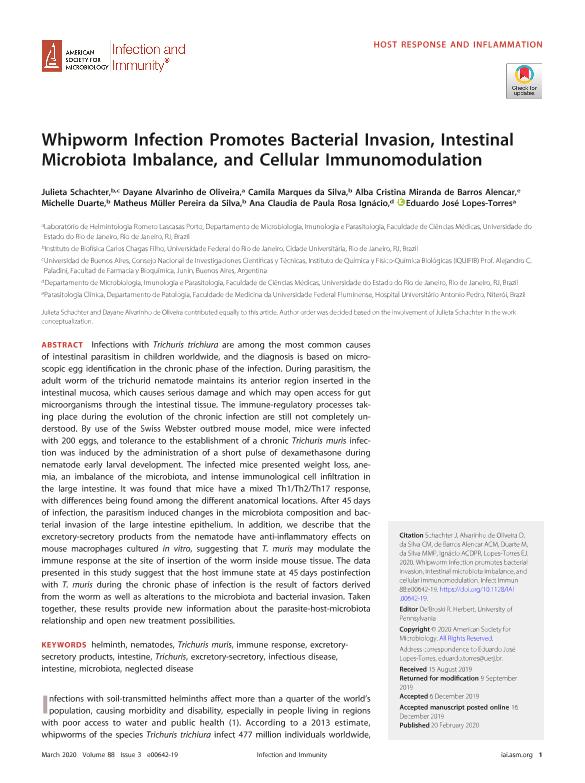Mostrar el registro sencillo del ítem
dc.contributor.author
Schachter, Julieta

dc.contributor.author
De Oliveira, Dayane Alvarinho
dc.contributor.author
Da Silva, Camila Marques
dc.contributor.author
De Barros Alencar, Alba Cristina Miranda
dc.contributor.author
Duarte, Michelle
dc.contributor.author
Müller Pereira da Silva, Matheus
dc.contributor.author
De Paula Rosa Ignácio, Ana Claudia
dc.contributor.author
Lopes Torres, Eduardo José
dc.date.available
2021-12-22T15:21:14Z
dc.date.issued
2020-03
dc.identifier.citation
Schachter, Julieta; De Oliveira, Dayane Alvarinho; Da Silva, Camila Marques; De Barros Alencar, Alba Cristina Miranda; Duarte, Michelle; et al.; Whipworm infection promotes bacterial invasion, intestinal microbiota imbalance, and cellular immunomodulation; American Society for Microbiology; Infection and Immunity; 88; 3; 3-2020; 1-24
dc.identifier.issn
0019-9567
dc.identifier.uri
http://hdl.handle.net/11336/149182
dc.description.abstract
Infections with Trichuris trichiura are among the most common causes of intestinal parasitism in children worldwide, and the diagnosis is based on microscopic egg identification in the chronic phase of the infection. During parasitism, the adult worm of the trichurid nematode maintains its anterior region inserted in the intestinal mucosa, which causes serious damage and which may open access for gut microorganisms through the intestinal tissue. The immune-regulatory processes taking place during the evolution of the chronic infection are still not completely understood. By use of the Swiss Webster outbred mouse model, mice were infected with 200 eggs, and tolerance to the establishment of a chronic Trichuris muris infection was induced by the administration of a short pulse of dexamethasone during nematode early larval development. The infected mice presented weight loss, anemia, an imbalance of the microbiota, and intense immunological cell infiltration in the large intestine. It was found that mice have a mixed Th1/Th2/Th17 response, with differences being found among the different anatomical locations. After 45 days of infection, the parasitism induced changes in the microbiota composition and bacterial invasion of the large intestine epithelium. In addition, we describe that the excretory-secretory products from the nematode have anti-inflammatory effects on mouse macrophages cultured in vitro, suggesting that T. muris may modulate the immune response at the site of insertion of the worm inside mouse tissue. The data presented in this study suggest that the host immune state at 45 days postinfection with T. muris during the chronic phase of infection is the result of factors derived from the worm as well as alterations to the microbiota and bacterial invasion. Taken together, these results provide new information about the parasite-host-microbiota relationship and open new treatment possibilities.
dc.format
application/pdf
dc.language.iso
eng
dc.publisher
American Society for Microbiology

dc.rights
info:eu-repo/semantics/openAccess
dc.rights.uri
https://creativecommons.org/licenses/by-nc-sa/2.5/ar/
dc.subject
EXCRETORY-SECRETORY
dc.subject
EXCRETORYSECRETORY PRODUCTS
dc.subject
HELMINTH
dc.subject
IMMUNE RESPONSE
dc.subject
INFECTIOUS DISEASE
dc.subject
INTESTINE
dc.subject
INTESTINE
dc.subject
MICROBIOTA
dc.subject
NEGLECTED DISEASE
dc.subject
NEMATODES
dc.subject
TRICHURIS
dc.subject
TRICHURIS MURIS
dc.subject.classification
Biología Celular, Microbiología

dc.subject.classification
Ciencias Biológicas

dc.subject.classification
CIENCIAS NATURALES Y EXACTAS

dc.title
Whipworm infection promotes bacterial invasion, intestinal microbiota imbalance, and cellular immunomodulation
dc.type
info:eu-repo/semantics/article
dc.type
info:ar-repo/semantics/artículo
dc.type
info:eu-repo/semantics/publishedVersion
dc.date.updated
2021-09-07T19:16:55Z
dc.journal.volume
88
dc.journal.number
3
dc.journal.pagination
1-24
dc.journal.pais
Estados Unidos

dc.description.fil
Fil: Schachter, Julieta. Universidade Federal do Rio de Janeiro; Brasil. Consejo Nacional de Investigaciones Científicas y Técnicas. Oficina de Coordinación Administrativa Houssay. Instituto de Química y Físico-Química Biológicas "Prof. Alejandro C. Paladini". Universidad de Buenos Aires. Facultad de Farmacia y Bioquímica. Instituto de Química y Físico-Química Biológicas; Argentina
dc.description.fil
Fil: De Oliveira, Dayane Alvarinho. Universidade do Estado de Rio do Janeiro; Brasil
dc.description.fil
Fil: Da Silva, Camila Marques. Universidade Federal do Rio de Janeiro; Brasil
dc.description.fil
Fil: De Barros Alencar, Alba Cristina Miranda. Hospital Universitario Antonio Pedro; Brasil
dc.description.fil
Fil: Duarte, Michelle. Universidade Federal do Rio de Janeiro; Brasil
dc.description.fil
Fil: Müller Pereira da Silva, Matheus. Universidade Federal do Rio de Janeiro; Brasil
dc.description.fil
Fil: De Paula Rosa Ignácio, Ana Claudia. Universidade do Estado de Rio do Janeiro; Brasil
dc.description.fil
Fil: Lopes Torres, Eduardo José. Universidade do Estado de Rio do Janeiro; Brasil
dc.journal.title
Infection and Immunity

dc.relation.alternativeid
info:eu-repo/semantics/altIdentifier/doi/http://dx.doi.org/10.1128/IAI.00642-19
dc.relation.alternativeid
info:eu-repo/semantics/altIdentifier/url/https://journals.asm.org/doi/10.1128/IAI.00642-19
Archivos asociados
